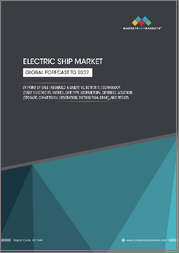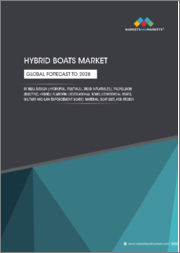
|
시장보고서
상품코드
1577015
전기 선박 시장, 기회, 성장 촉진요인, 산업 동향 분석 및 예측(2024-2032년)Electric Ships Market, Opportunity, Growth Drivers, Industry Trend Analysis and Forecast, 2024-2032 |
||||||
세계 전기 선박 시장은 2023년 40억 2,000만 달러로 평가되었고, 2024년부터 2032년까지 연평균 24.6% 이상 성장할 것으로 예상됩니다.
환경에 대한 관심이 높아지고 규제가 강화됨에 따라 해운업계는 더 깨끗한 대안으로 전기 선박과 전기 선박에 대한 관심이 높아지고 있습니다. 전기 선박은 온실 가스 배출을 크게 줄일 뿐만 아니라 소음 공해를 줄일 수 있어 도시 수로와 환경에 민감한 지역에 적합합니다. 정부의 인센티브와 보조금은 이러한 수요를 더욱 촉진하고 지속 가능한 관행을 장려하고 있습니다.
또한, 해운업계의 전기 추진으로의 전환은 전기자동차의 급증으로 대표되는 광범위한 운송 트렌드를 반영하고 있습니다. 이러한 변화는 기존 화석 연료로 구동되는 선박이 환경에 미치는 영향에 대한 소비자와 운항자의 인식이 높아지면서 더욱 가속화되고 있습니다. 예를 들어, 핀란드 경제고용부는 2022년 5월, 저탄소 기술과 디지털 솔루션을 강조하는 지속가능한 해양 산업 육성 프로그램을 시작했습니다.
전기 선박 분야에서는 전기 엔진과 기존 디젤 및 가스 엔진을 결합한 하이브리드 추진 시스템이 널리 보급되고 있습니다. 이러한 시스템은 특히 고출력이 필요한 선박에 유연성과 효율성을 제공하며, 그렇지 않은 경우 전기로 효율적으로 항해할 수 있습니다. 이러한 이중 기능은 연료 소비를 줄일 뿐만 아니라, 특히 규제된 항구와 보호 수역에서 배출을 최소화할 수 있습니다.
동력원별 시장 세분화를 보면 전기와 하이브리드로 나뉘며, 2023년에는 하이브리드가 시장 점유율의 57% 이상을 차지하며 우위를 점할 것으로 예상됩니다. 하이브리드 부문의 우위는 하이브리드 부문이 제공하는 운영 유연성과 효율성에 기인합니다. 전기 추진을 기존 내연 기관과 통합함으로써 하이브리드 선박은 연료 소비를 최적화하고 배출 가스를 줄이며 특히 항구와 같은 배출에 민감한 지역에서 환경 규정을 준수 할 수 있습니다. 이러한 이중 동력의 장점은 페리, 화물선, 해양 지원 선박과 같은 장거리 선박에 매우 유용합니다.
플랫폼별 세분화에서 전기 선박 시장은 상업 부문과 방산 부문으로 나뉘며, 2023년에는 상업 부문이 가장 빠르게 성장하여 연평균 24% 이상의 CAGR을 나타낼 것으로 예상됩니다. 이러한 모멘텀을 바탕으로 2032년까지 상업용 부문 시장 가치는 220억 달러 이상에 달할 것으로 예상됩니다. 상업용 부문의 빠른 성장을 주도하는 것은 환경에 대한 인식이 높아지고 온실 가스 배출을 억제하기 위한 규제 압력이 증가하고 있기 때문입니다.
2023년 유럽이 전기 선박 시장을 장악하고 37% 이상의 점유율을 차지할 것으로 예상됩니다. 이러한 리더십은 유럽의 환경 지속가능성에 대한 확고한 약속과 강력한 규제 프레임워크를 강조합니다. 야심찬 탄소 감축 목표와 대기 환경 개선에 힘입어 유럽 국가들은 친환경 기술 도입의 선구자이며, EU의 배출 규제 지역(ECA) 및 국제 해사기구(IMO)의 유황 상한선 등의 규제 조치도 시장 상황을 크게 형성했습니다.
목차
제1장 조사 범위와 조사 방법
- 시장 범위와 정의
- 기본 추정과 계산
- 예측 파라미터
- 데이터 소스
- 1차 데이터
- 2차 데이터
- 유료 소스
- 공적 정보원
제2장 주요 요약
제3장 업계 인사이트
- 생태계 분석
- 벤더 매트릭스
- 기술 및 혁신 전망
- 특허 분석
- 주요 뉴스와 이니셔티브
- 규제 상황
- 영향요인
- 성장 촉진요인
- 업계의 잠재적 리스크&과제
- 성장 가능성 분석
- Porter's Five Forces 분석
- PESTEL 분석
제4장 경쟁 구도
- 기업 점유율 분석
- 경쟁 포지셔닝 매트릭스
- 전략 전망 매트릭스
제5장 시장 추산·예측 : 동력원별, 2021년-2032년
- 주요 동향
- 전기자동차
- 하이브리드
제6장 시장 추산·예측 : 시스템별, 2021년-2032년
- 주요 동향
- 에너지 저장
- 전력 변환
- 발전
- 배전
제7장 시장 추산·예측 : 오퍼레이션별, 2021년-2032년
- 주요 동향
- 유인
- 자율형
제8장 시장 추산·예측 : 플랫폼별, 2021년-2032년
- 주요 동향
- 상용
- 방위
제9장 시장 추산·예측 : 용도별, 2021년-2032년
- 주요 동향
- LINE-FIT
- RETROFIT
제10장 시장 추산·예측 : 지역별, 2021년-2032년
- 주요 동향
- 북미
- 미국
- 캐나다
- 유럽
- 영국
- 독일
- 프랑스
- 이탈리아
- 스페인
- 기타 유럽
- 아시아태평양
- 중국
- 인도
- 일본
- 한국
- 뉴질랜드
- 기타 아시아태평양
- 라틴아메리카
- 브라질
- 멕시코
- 기타 라틴아메리카
- 중동 및 아프리카
- 아랍에미리트(UAE)
- 사우디아라비아
- 남아프리카공화국
- 기타 중동 및 아프리카
제11장 기업 개요
- Austal
- BMT Group
- Brodrene Aa AS
- China State Shipbuilding Corporation(CSSC)
- Damen Shipyards Group
- Duffy Electric Boat Company
- Fincantieri
- Fjord1
- Gladding-Hearn Shipbuilding
- Hyundai Heavy Industries(HHI)
- Imabari Shipbuilding
- Kawasaki Heavy Industries
- Leclanche
- MV Yara Birkeland
- Navantia
- Norwegian Electric Systems As
- Samsung Heavy Industries
- Tuco Marine Group
- Vard Marine
- Wartsila
The Global Electric Ships Market was valued at USD 4.02 billion in 2023 and is projected to grow at a CAGR of over 24.6% from 2024 to 2032. As environmental concerns mount and regulations tighten, the maritime industry is increasingly turning to electric boats and ships as cleaner alternatives. Electric vessels not only significantly cut down greenhouse gas emissions but also reduce noise pollution, making them ideal for urban waterways and environmentally sensitive regions. Government incentives and subsidies further bolster this demand, promoting sustainable practices.
Furthermore, the maritime industry's pivot to electric propulsion mirrors broader trends in transportation, notably the surge of electric vehicles. This shift is also driven by heightened awareness among consumers and operators regarding the environmental repercussions of traditional fossil-fuel-powered vessels. For example, in May 2022, Finland's Ministry of Economic Affairs and Employment initiated a program to foster a sustainable maritime industry, emphasizing low-carbon technologies and digital solutions.
Hybrid propulsion systems, merging electric and traditional diesel or gas engines, are gaining traction in the electric ships sector. These systems provide operational flexibility and efficiency, especially for vessels needing high power at times but can run efficiently on electric power otherwise. Such dual capability not only curtails fuel consumption but also minimizes emissions, particularly in regulated ports or protected waters.
The overall industry is divided into power source, system, operation, platform, end use , and region.
The market segmentation by power source reveals a split between electric and hybrid systems. In 2023, hybrids dominated, capturing over 57% of the market share. The hybrid segment's dominance stems from the operational flexibility and efficiency it offers. By integrating electric propulsion with traditional combustion engines, hybrid ships can optimize fuel consumption, lower emissions, and adhere to environmental regulations, especially in emission-sensitive areas like ports. This dual-power advantage is invaluable for long-distance vessels, including ferries, cargo ships, and offshore support vessels.
Segmentation by platform categorizes the electric ships market into commercial and defense sectors. In 2023, the commercial segment emerged as the fastest growing, boasting a CAGR exceeding 24%. Given this momentum, the commercial segment's market value is projected to surpass USD 22 billion by 2032. Driving the commercial segment's rapid ascent is a heightened environmental consciousness and mounting regulatory pressures to curb greenhouse gas emissions.
In 2023, Europe dominated the electric ships market, holding a share exceeding 37%. This leadership underscores Europe's unwavering commitment to environmental sustainability and its robust regulatory frameworks. European nations, propelled by ambitious carbon reduction targets and air quality improvements, have been pioneers in green technology adoption. Regulatory measures, like the EU's Emission Control Areas (ECAs) and the International Maritime Organization's (IMO) sulfur cap, have also profoundly shaped the market landscape.
Table of Contents
Chapter 1 Scope and Methodology
- 1.1 Market scope and definition
- 1.2 Base estimates and calculations
- 1.3 Forecast parameters
- 1.4 Data sources
- 1.4.1 Primary
- 1.4.2 Secondary
- 1.4.2.1 Paid sources
- 1.4.2.2 Public sources
Chapter 2 Executive Summary
- 2.1 Industry 360° synopsis, 2021-2032
Chapter 3 Industry Insights
- 3.1 Industry ecosystem analysis
- 3.2 Vendor matrix
- 3.3 Technology and innovation landscape
- 3.4 Patent analysis
- 3.5 Key news and initiatives
- 3.6 Regulatory landscape
- 3.7 Impact forces
- 3.7.1 Growth drivers
- 3.7.1.1 Shift toward low emission technologies
- 3.7.1.2 Rising integration of renewable energy sources
- 3.7.1.3 Stringent environmental regulations imposed by international and national maritime authorities
- 3.7.1.4 Growing adoption of electric boats and ships
- 3.7.1.5 Technological advancements in battery technology and electric propulsion systems
- 3.7.2 Industry pitfalls and challenges
- 3.7.2.1 High initial costs and technical issues
- 3.7.2.2 Limited range and battery life of current electric propulsion systems
- 3.7.1 Growth drivers
- 3.8 Growth potential analysis
- 3.9 Porter's analysis
- 3.9.1 Supplier power
- 3.9.2 Buyer power
- 3.9.3 Threat of new entrants
- 3.9.4 Threat of substitutes
- 3.9.5 Industry rivalry
- 3.10 PESTEL analysis
Chapter 4 Competitive Landscape, 2023
- 4.1 Company market share analysis
- 4.2 Competitive positioning matrix
- 4.3 Strategic outlook matrix
Chapter 5 Market Estimates and Forecast, By Power Source, 2021-2032 (USD Million and Units)
- 5.1 Key trends
- 5.2 Electric
- 5.3 Hybrid
Chapter 6 Market Estimates and Forecast, By System, 2021-2032 (USD Million and Units)
- 6.1 Key trends
- 6.2 Energy storage
- 6.3 Power conversion
- 6.4 Power generation
- 6.5 Power distribution
Chapter 7 Market Estimates and Forecast, By Operation, 2021-2032 (USD Million and Units)
- 7.1 Key trends
- 7.2 Manned
- 7.3 Autonomous
Chapter 8 Market Estimates and Forecast, By Platform, 2021-2032 (USD Million and Units)
- 8.1 Key trends
- 8.2 Commercial
- 8.3 Defense
Chapter 9 Market Estimates and Forecast, By End-Use, 2021-2032 (USD Million and Units)
- 9.1 Key trends
- 9.2 Line fit
- 9.3 Retro fit
Chapter 10 Market Estimates and Forecast, By Region, 2021-2032 (USD Million and Units)
- 10.1 Key trends
- 10.2 North America
- 10.2.1 U.S.
- 10.2.2 Canada
- 10.3 Europe
- 10.3.1 UK
- 10.3.2 Germany
- 10.3.3 France
- 10.3.4 Italy
- 10.3.5 Spain
- 10.3.6 Rest of Europe
- 10.4 Asia Pacific
- 10.4.1 China
- 10.4.2 India
- 10.4.3 Japan
- 10.4.4 South Korea
- 10.4.5 ANZ
- 10.4.6 Rest of Asia Pacific
- 10.5 Latin America
- 10.5.1 Brazil
- 10.5.2 Mexico
- 10.5.3 Rest of Latin America
- 10.6 MEA
- 10.6.1 UAE
- 10.6.2 Saudi Arabia
- 10.6.3 South Africa
- 10.6.4 Rest of MEA
Chapter 11 Company Profiles
- 11.1 Austal
- 11.2 BMT Group
- 11.3 Brodrene Aa AS
- 11.4 China State Shipbuilding Corporation (CSSC)
- 11.5 Damen Shipyards Group
- 11.6 Duffy Electric Boat Company
- 11.7 Fincantieri
- 11.8 Fjord1
- 11.9 Gladding-Hearn Shipbuilding
- 11.10 Hyundai Heavy Industries (HHI)
- 11.11 Imabari Shipbuilding
- 11.12 Kawasaki Heavy Industries
- 11.13 Leclanche
- 11.14 MV Yara Birkeland
- 11.15 Navantia
- 11.16 Norwegian Electric Systems As
- 11.17 Samsung Heavy Industries
- 11.18 Tuco Marine Group
- 11.19 Vard Marine
- 11.20 Wartsila


















